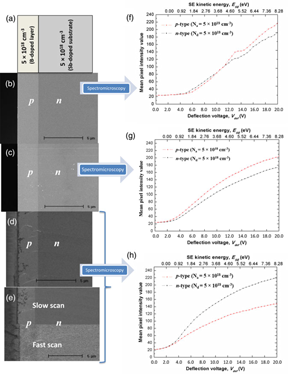Article contents
The Mechanistic Determination of Doping Contrast from Fermi Level Pinned Surfaces in the Scanning Electron Microscope Using Energy-Filtered Imaging and Calculated Potential Distributions
Published online by Cambridge University Press: 22 September 2022
Abstract

Secondary electron (SE) doping contrast in the scanning electron microscope is correlated with Fermi level pinned surfaces of Si samples prepared using HF-based wet-chemical treatment or focused ion beam (FIB) micromachining en route to quantitative dopant profiling. Using energy-resolved SE imaging techniques and finite-element analyses of surface states and surface junction potentials, we clarified the surface band-bending effects post-NH4F-treatment, consistent with brighter p-contrast from degenerately doped (>1019 cm−3) regions. In general, SE spectromicroscopy scan measurements unambiguously indicated heavy suppression of patch fields, while the empirical discovery of scan frequency-modulated contrast inversion due to Chee et al. [Springer Proceedings in Physics, 120, pp. 407–410 (2008)] is ascribable to competing fixed oxide charge and dynamic charge injection phenomena (particularly at dwell times >29 μs). Leveraging numerical simulations of electric potentials and variable-voltage experimental data, the theoretical model based on amorphization damage-mediated Fermi level pinning is elucidated for Ga+ FIB-processed site-specific doping contrast on patch field-free surfaces. This work successfully argues against the notion that doping contrast ultimately or exclusively entails patch fields or adventitious metal–semiconductor contacts.
- Type
- Software and Instrumentation
- Information
- Copyright
- Copyright © The Author(s), 2022. Published by Cambridge University Press on behalf of the Microscopy Society of America
References
- 10
- Cited by


